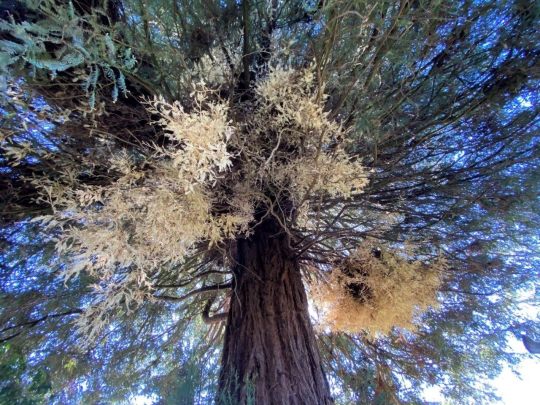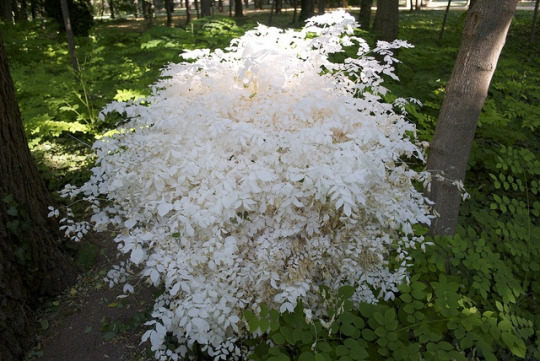#stromata
Explore tagged Tumblr posts
Text
youtube
The sequel to Siren, Stromata.
1 note
·
View note
Text











I set a trap to come and catch you oh, someone stop me now, I can't do this
#pit babe#pit babe the series#petekenta#garfield pantach#ping obrnithi#pitbabeedit#thai bl#thai drama#bl drama#bl series#lyrics: charlotte martin - stromata#i'm honestly being consumed by petekenta right now#i mean i love love love kentakim and peteway but#i'm going feral#by pharawee
610 notes
·
View notes
Photo
Albino redwoods are the ABSOLUTE COOLEST. My family spent some time in the redwoods the summer after I took AP biology and I spent the whole trip obsessing over them. Here's some of what I remember!
Some redwoods have a combination of albino branches and wild type/chlorophyll producing branches. They're called chimeras and they're GORGEOUS (pics below). These trees express both sets of DNA along clearly delineated areas of the tree. Genetically, it's the same thing that's going on with calico cats
Most albino redwoods only grow to shrub or sapling size, but a few can grow to 30+ ft. Only the full-sized, mature trees produce cones. (Ie most albino redwoods arise due to new mutation and immediate natural selection, not heredity)
The filtration abilities are a direct size effect of the no chloroplasts thing. No chloroplasts -> weak stromata (bc it's basically just matrix) -> inefficient water transport and poor retention -> lots of uptake of environmental toxins, but poor retention. Kind of like flushing toxins out of our bodies! This kind of anatomy is really costly to the individual organism but, as discussed above, highly beneficial to the community. (Also, what even is an individual organism? Jury's still out lol)
There tend to be more viable albino redwoods near industrial/otherwise contaminated areas, as well as during periods of drought. Evolutionarily, this suggests that wild type trees might be behaving altruistically when the environment is stressful, allowing albinos to survive and thrive (the 30-footers). In contrast, during times of low stress, most albinos are ephemeral and die quickly.
Ecologically, this also means that albino redwood success might be a useful marker for localized environmental stress. They're the "white flags of the forest."
Chimera:

Large albino redwood:

More typical albino redwood, like the one I remember seeing:


Trees, like animals, can also experience albinism, though it is extremely rare.
#endless forms most beautiful#seriously these things are the coolest#i googled and googled and couldn't shut up about them#if I had access to my mom's computer right now I could add like 50 photos that i took that trip#unfortunately it was before i got a cell phone#also this is all accurate to the best of my recollection but feel free to fact check me#it was a while ago that I went on my albino redwood kick and memory is fallible etc#also: cute for Tumblr but the anthropomorphizing going on in some of the above responses itches in my brain#the driving force in nature is the propagation of one's genes. trees aren't ever gonna be altruistic just for the heck of it
382K notes
·
View notes
Text
Devocional diário
DESCOBERTAS da fé - RODRIGO SILVA
QUEM É DEUS
Com quem vocês vão Me comparar? A quem Eu seria igual? E que coisa semelhante confrontarão Comigo? Isaías 46:5
Xenófanes foi um pensador grego que, criticando as ideias religiosas de sua época, escreveu: “Os etíopes dizem que seus deuses são negros com o nariz achatado, já os trácios dizem que seus [deuses] tem olhos azuis e cabelos ruivos. Se bois, cavalos e leões tivessem mãos e pudessem desenhar ou talvez esculpir como os homens, então os cavalos desenhariam seus deuses como cavalos, os bois como bois, e cada um faria corpos para seus deuses conforme sua própria semelhança” (citado por Clemente de Alexandria, Stromata 5:14 e 7:4).
Embora seja verdade que muitos fabricaram seus deuses ao longo da história, o Deus da Bíblia é grande demais para ser um produto de nossa mente. Mesmo que usemos linguagem humana para descrevê-Lo, Sua essência está além da nossa imaginação. Ele é eterno, onipresente, onipotente e onisciente. Os gregos criaram Zeus, e os babilônios, Marduque, mas nem os hebreus nem quaisquer outros povos seriam capazes de inventar o Senhor.
O mesmo se aplica a Jesus Cristo, que é Deus em forma humana. De acordo com o filósofo Jean-Jacques Rousseau, “os evangelhos têm traços de verdade tão grandes, tão impressionantes, tão perfeitamente inimitáveis que seu inventor teria de ser mais espantoso que seu herói” (Emilius and Sophia, or, an Essay on Education, p. 81). Ou seja, eles não podem ser fruto da genialidade humana.
Stuart Mill, um dos mais céticos e influentes economistas do século 19, admitiu que Jesus era a maior prova de Sua existência, pois se Cristo não existisse, nem nós, nem Seus discípulos, seríamos capazes de inventá-Lo. E, finalmente, o ex-ateu C.S. Lewis disse: “Seria preciso alguém maior que Jesus para inventar Jesus. A causa sempre é maior que o efeito.”
Não há na natureza nada que equivalha precisamente ao ser de Deus. Contudo, não fomos deixados às cegas quanto à Sua maravilhosa pessoa. Quando me perguntam como Ele é, não preciso de especulações filosóficas para dar uma resposta. Basta saber quem foi Jesus, e terei o quadro preciso de quem é Deus. Se hoje você quiser aprender mais acerca de Deus, comece aprendendo sobre Jesus; Ele é o retrato autêntico de Deus, o Pai.
0 notes
Text
Pitágoras aconsejaba que es mejor gustar de las Musas que de las Sirenas y enseñaba a practicar la sabiduría sin gusto sensible rechazando como engañoso el encantamiento. Para sobresalir frente a las Sirenas bastó tan solo uno, y para responder a la Esfinge también uno solo…
Clemente de Alejandría Stromata I, Capítulo X, 48.5
El que sobresalió, venció, a las Sirenas fue Odiseo (Ulises) en la Odisea atribuido a Homero y escrito 800 ó 700 años antes de Cristo.
Canto (poema) XII, extracto
Circe, hechicera enamorada de Odiseo le advierte de las Sirenas:
- En primer lugar llegarás junto a las Sirenas, las que hechizan a todos los humanos que se aproximan a ellas. Cualquiera que en su ignorancia se les acerca y escucha la voz de las Sirenas, a ése no le abrazarán de nuevo su mujer ni sus hijos contentos de su regreso a casa. Allí las Sirenas lo hechizan con su canto fascinante, situadas en una pradera. En torno a ellas amarillea un enorme montón de huesos y renegridos pellejos putrefactos.
Prosigue la narración Odiseo
… yo corté con mi aguda espada un gruesa tajada de cera y la fui moldeando en pequeños trozos con mis robustas manos. Pronto se caldeaba la cera, ya que la forzaba una fuerte presión de los rayos de Helios, el soberano Hiperiónida. A todos mis compañeros, uno tras otro, les taponé con la masa los oídos. Y ellos me ataron a su vez de pies y manos en la nave, erguido junto al mástil, y reforzaron las amarras de este.
Cantan ahora las Sirenas
- Ven, acércate, muy famoso Odiseo, gran gloria de los aqueos! Detén tu navío para escuchar nuestra voz! Pues jamás paso de largo por aquí nadie en su negra nave sin escuchar la voz dulce del encanto de nuestra boca. Sino que ése, deleitándose, navega luego más sabio.
Continúa Odiseo
- Así decían desplegando su bella voz. Y mi corazón anhelaba escucharlas, y ordenaba a mis compañeros que me desataran haciendo gestos con mis cejas. Ellos se curvaban y bogaban. Pronto se pusieron en pie Perimedes y Eurícolo y vinieron a sujetarme más firmemente con las sogas. Cuando ya las hubimos pasado y no escuchamos más ni la voz ni la canción de las Sirenas, al punto mis fieles compañeros se quitaron la cera con la que les había ataponado los oidos, y me libraron de las cuerdas.
Termina el extracto.
Según Justino << todos los escritores, por la semilla del logos inmersa en la naturaleza, pudieron ver la realidad de las cosas aunque de manera oscura >>.
Hay que descubrir <<con gozo y respeto las semillas de la Palabra que en ellas [en todas las culturas] laten>>. Ad Gentes 11.
Ulises es figura de Cristo. Protege a sus compañeros cerrado sus oídos al mal y abriéndolos a la verdad. Ulises escucha la invitación de las Sirenas a soltarse igual que Cristo en la cruz escuchó cuando le decían que si era Dios se bajara de la Cruz. Distinto a Ulises, Cristo se podía soltar. Las Sirenas prometían que navegaría más sabio. Cristo es la sabiduría de Dios, su palabra, el verbo encarnado, el logos. Las Sirenas ofrecían vida para causar muerte. Las Sirenas mentían. Cristo es la verdad. Cristo ofrece su muerte para causar vida. Ulises y Cristo se ataron voluntariamente al madero; Ulises al mástil, Cristo a la cruz.
0 notes
Text
"Prayer is, then, to speak more boldly, converse with God. Though whispering, consequently, and not opening the lips, we speak in silence, yet we cry inwardly."
— Clement of Alexandria, Stromata 7.7
0 notes
Text
How much would you be willing to stake on a rumor? What if you could not trace the rumor to within the lifetime of its subject? Not within a century of the lifetime of its subject? What if you could not reliably trace this rumor to within 150 years of the lifetime of its subject, and in the meantime the closest statement on the matter points to a completely different conclusion?
The Book of Revelation is prophetic, which means various elements in it, the fall of Babylon the Great, the defeat of the Serpent, and the Seven Scrolls and Seven Trumpets were in John's future. If one looks only to Scripture and does not consult scholarship or newspaper headlines for a source of interpretation, one will find similarities in how John describes Babylon the Great to how Judah is described in Jeremiah 3-4. One will find the kings of the Earth taking charge against the Christ in Psalm 2 and Acts 4, and see this mirrored in Acts 17. One will find a double-sided, edible, honey-flavored scroll that Ezekiel eats before pronouncing judgements against Israel, and John pronouncing similar judgements on "the Earth" and "Babylon" after eating a similar scroll. It is worth noting that national Israel ceased to exist in AD 70.
In the Book of Revelation, John mentions that he is at Patmos, seemingly in exile. He does not specify when he was exiled or when he was writing. None of his known contemporaries give details as to when John was exiled or wrote Revelation. John is not mentioned in the Didache, the Shepherd of Hermas, or the Epistles to Barnabas or Diognetus. John is believed to have died no later than AD 110; within a century of his death, the closest any Church Father writes to an estimate of when John might have written Revelation is Clement of Alexandria. Around the turn of the third century, he wrote in Book VII of his Stromata that the ministry of the Apostles ended during the reign of Nero. If this ministry included prophetic visions, then John would have received his vision which he wrote in Revelation no later than AD 68, assuming Clement's assessment is correct some 130 years after the fact.
The other church fathers throughout the second century and for at least the first half of the third century either gave no details about John's exile, or stated that John was at Patmos in the last decade of the first century, but were unclear about how long he had been there, or whether he was writing apocalyptic literature at that time. In the fifth book of Against Heresies, Irenaeus wrote the following:
"We will not, however, incur the risk of pronouncing positively as to the name of Antichrist; for if it were necessary that his name should be distinctly revealed in this present time, it would have been announced by him who beheld the apocalyptic vision. For [that] was seen no very long time since, but almost in our day, towards the end of Domitian's reign."
The bracketed word notes a lack of clarity as to what, exactly, was last seen. While it is possible he is stating that the vision was seen during the reign of Domitian, he could have just as easily been claiming that John was seen during the reign of Domitian, the latter a less controversial statement. The Greek text lacks a nominative pronoun, and thus the wording remains vague.
The first unambiguous claim that John was exiled to Patmos during the reign of Domitian comes from the Victornius's commentary on Revelation. This same commentary makes oblique references to the Valerian Persecution, which occurred in AD 260. This means that 150 years passed from John's death to the first known, unambiguous, written assertion that he was exiled to Patmos during the reign of Domitian. No contemporaries of John, and no early biographers of John make so clear a statement. Two generations of people were born and began to die of old age during this time. To believe such a claim wholeheartedly is historically laughable.
#john of patmos#revelation#revelation of john#apocalypse of john#preterism#preterist#New Testament chronology
0 notes
Text

Το προσδόκιμο ζωής είναι κατά 2,3 χρόνια μικρότερο στα κατώτερα μορφωτικά στρώματα σε σχέση με τα ανώτερα https://health.rodos-island.gr/prosdokimo-zois-einai-kata-chronia-mikrotero-sta-katotera-morfotika-stromata/
0 notes
Text
Το προσδόκιμο ζωής είναι 2,3 χρόνια μικρότερο στα κατώτερα μορφωτικά στρώματα σε σχέση με τα ανώτερα
https://travel-tourism.news-24.gr/prosdokimo-zois-einai-chronia-mikrotero-sta-katotera-morfotika-stromata-schesi/
0 notes
Text
Το εύκολο tip για να φρεσκάρετε τα στρώματα
https://gossip.rodos-island.gr/to-efkolo-tip-gia-na-freskarete-ta-stromata/
0 notes
Text

"Xylaria polymorpha, commonly known as dead man's fingers, is a saprobic fungus growing from the bases of rotting tree stumps and decaying wood. It has elongated upright stromata poking up through the ground, much like fingers.
"More details/photos: http://bit.ly/3YRpl0Q"
h/t David Attenborough Fans
0 notes
Note
Is there a myth or many for the moons phases in greek mythology? Because I can't find any
Hey! 🌕
In terms of moon phases specifically, the info is pretty scarce. I'm planning to do a bigger deep dive into this if I find the time and will share more if/when I get it.
But for now, here's what I found on Selene's Wikipedia page, as she is considered to be the personification of the moon itself. It seems much of the moon phase related info connects directly back to her.
I'll seek out and share Artemis and Hekate related moon phase mythology if I find it.
����🌓🌔🌕🌖🌗🌘
Selene was said to carry the moon across the sky in her chariot, thus controlling its phases. The Homeric Hymn to Selene gives the following description:
"The air, unlit before, glows with the light of her golden crown, and her rays beam clear, whensoever bright Selene having bathed her lovely body in the waters of Ocean, and donned her far-gleaming raiment, and yoked her strong-necked, shining team, drives on her long-maned horses at full speed, at eventime in the mid-month: then her great orbit is full and then her beams shine brightest as she increases. So she is a sure token and a sign to mortal men. (Hymn 32)"
Selene was sometimes associated with childbirth, for it was believed that during the full moon women had the easiest labours; this helped in her identification with the goddess Artemis, as well as other goddesses connected to women's labours. (Cited from the writing of Chrysippus of Soli)
According to a certain Epigenes, the three Moirai, or Fates, were regarded in the Orphic tradition as representing the three divisions of Selene, "the thirtieth and the fifteenth and the first" (i.e. the crescent moon, full moon, and dark moon, as delinted by the divisions of the calendar month) (cited from Clement of Alexandria's Stromata: Abel, frg. 253.)
🌙
0 notes
Text

Xylaria polymorpha, commonly known as dead man's fingers, is a saprobic fungus growing from the bases of rotting tree stumps and decaying wood. It has elongated upright stromata poking up through the ground, much like fingers.
0 notes
Text
TRYPOPHOBIA IS DESCRIBED AS AN INTENSE SENSE OF REVULSION TOWARD IMAGES OF REPEATED HOLES. I SAW AN IMAGE OF THE STROMATA ON THE BOTTOM OF A LEAF IN A BIOLOGY LAB AND FELT LIKE I WAS GOING TO VOMIT. I LOOKED UP TRYPOPHOBIA AND FOUND SEVERAL EXTREMELY TRIGGERING IMAGES.
GAHHH WHAT A TERRIBLE WAY TO FIND OUT YOU HAVE TRYPOPHOBIA
5 notes
·
View notes
Text
SAINT OF THE DAY (December 4)

December 4 was once the traditional feast day of an early Christian theological author whose legacy is controversial, but who is cited as a saint in the Catechism of the Catholic Church and has been described as such in several addresses of Pope Benedict XVI.
The writer in question is Saint Clement of Alexandria (c. 150 A.D.–c. 215 A.D.), who led the city's famous Catechetical School during the late second century.
Clement is not always referred to as a saint in Church documents, and his feast day was removed from the Western liturgical calendar around the year 1600 due to suspicions about some of his writings.
Eastern Christian traditions also seem to regard him with some reluctance.
On the other hand, he is called “St. Clement of Alexandria” not only in the Catholic catechism but also in the Compendium of the Social Doctrine of the Church.
On 28 October 2012, during his homily at the closing Mass for the Synod on the New Evangelization, Pope Benedict XVI made a notable public reference to him as “Saint Clement of Alexandria,” as he has done elsewhere.
On that occasion, the Pope concluded his homily with a long quotation from St. Clement.
However, the title of “saint” was dropped during the Pope's earlier April 2007 audience talk on his life and writings.
In that general audience, however, Pope Benedict described Clement as a “great theologian” whose Christ-centered intellectual vision “can serve as an example to Christians, catechists and theologians of our time.”
Nine years earlier, Blessed John Paul II had cited his pioneering integration of philosophy and theology in his 1998 encyclical “Fides et Ratio.”
Clement's date of birth is not known, though he was most likely born in Athens and converted to Christianity later in life.
His intellectual curiosity prompted him to travel widely and study with a succession of teachers in the Mediterranean and the Middle East.
Eventually, Clement settled in Egypt where he studied under Pantaenus, a teacher at the Catechetical School of Alexandria.
Located in a cultural and commercial center, Alexandria's Catechetical School played an important role in the development of theology during the Church's early centuries.
Clement served as an assistant to Pantaenus and eventually became a teacher himself, taking a position of leadership in the school around 190.
His theological writings circulated before the century's end, and he may have become a priest.
During the early third century, persecution against the Church prompted Clement to leave Egypt for Cappadocia in Asia Minor.
One of his former students in that region, a bishop named Alexander, was jailed for his faith.
Clement stepped in to give direction to the faithful in Caesarea during their bishop's imprisonment.
Clement died in Cappadocia in approximately 215.
Clement and other Alexandrian teachers sought to express Catholic doctrines in a philosophically-influenced, intellectually rigorous manner.
Later Church Fathers, especially in the Greek tradition, owed much to their work.
But the school's legacy is mixed:
Origen, one of its main representatives and possibly Clement's student, is associated with doctrines later condemned by an ecumenical council.
Three of St. Clement of Alexandria's works survive:
The “Protreptikos” (“Exhortation”), which presents the Christian faith in contrast with paganism;
The “Paedagogus” (“The Tutor”), encouraging Christians in the disciplined pursuit of holiness; and
The “Stromata” (“Miscellanies” or “Tapestries”), which takes up the topic of faith in its relationship to human reason.
In a passage of the “Protrepikos” quoted by Pope Benedict XVI at the conclusion of the Synod for the New Evangelization, St. Clement encouraged his readers:
“Let us put away then, let us put away all blindness to the truth, all ignorance.
And removing the darkness that obscures our vision like fog before the eyes, let us contemplate the true God since a light from heaven shone down upon us who were buried in darkness and imprisoned in the shadow of death, (a light) purer than the sun, sweeter than life on this earth.”
11 notes
·
View notes
Text
… filosofía griega, en la que, al igual que en las nueces, no todo es comestible.
Clemente de Alejandría, Stromata I, 7.3.
0 notes